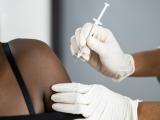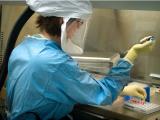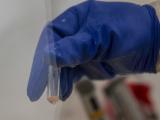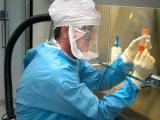Mar 17, 2005 (CIDRAP News) – The causes of this week's anthrax alarms in the Washington, DC, area remained a mystery today as criticisms about communication and coordination by the Department of Defense (DoD) flew.
It was still unclear why a military contractor laboratory detected anthrax on a sample from a mail facility next to the Pentagon in Arlington, Va., last week and why a sensor at a DoD office complex in Falls Church, Va., a few miles away, signaled a possible biological hazard on Mar 14.
The initial positive test on the Pentagon sample occurred Friday, Mar 11, but Pentagon officials were not notified until the following Monday morning, Mar 14, according to a New York Times report today.
The alarm at the DoD complex in Falls Church, called Baileys Crossroad Skyline, sounded at 2:30 Monday afternoon, when local officials still didn't know about the alert at the Pentagon hours earlier, according to numerous reports.
Testing of many environmental samples taken subsequently at both facilities detected no anthrax, officials said. But in the meantime, both buildings were closed, along with a Washington post office that feeds mail to the Pentagon and other agencies, and about 900 workers were advised to take antibiotics.
Speculation about the cause of the anthrax finding on the sample from the Pentagon facility has centered on possible laboratory contamination. Polymerase chain reaction (PCR) was used in the initial test in the contractor lab, according to a statement issued by the Centers for Disease Control and Prevention (CDC) last night. A Department of Homeland Security (DHS) lab at Fort Detrick, Md., ran a second PCR test on the same sample and confirmed the anthrax finding, the CDC said.
The DHS lab next analyzed a second part of the original sample by PCR and culture and this time detected no anthrax, the CDC reported. Subsequent tests of environmental samples by PCR and culture have all been negative. PCR results on the actual filter from the collection device at the Pentagon facility were still pending at the time of the CDC statement. Results were not available from the CDC or DoD as of this writing.
Officials have said they concluded that the initial test results were wrong. But an official at the contractor lab questioned that conclusion, according to the Times. Robert Harris, chief operating officer of Commonwealth Biotechnology in Richmond, Va., said he still believed that the original sample might have been a true positive.
The reason for the hazard signal at the Skyline office complex also remained unclear. The CDC statement said the alarm "proved to be from a particle counter rather than from a biological sensor." The statement didn't explain the difference between the two devices, and further information was not immediately available.
The anthrax scare triggered an outcry from state and local officials that DoD failed to adequately warn them about the situation. The episode also revealed differences between the way the Pentagon and other federal agencies deal with biological threats.
DC Mayor Anthony A. Williams and other elected leaders said the lack of coordination that occurred could be devastating in a real biological attack, according to a Washington Post report today.
"This may well be forgiven given the way the testing is coming out, but it certainly can't be excused," Williams said. "Not to have upfront contacts with the Department of Defense is really inexcusable."
Rep. Thomas M. Davis III, R-Va., called for a "regional response summit" to examine who was informed about the DoD investigation and when, the Post report said.
Pentagon officials said they followed standard procedure by calling the Arlington fire department at 10:30 Monday morning after they learned of the anthrax finding, the story said. The officials said they notified other fire departments in the area at 12:10 p.m.
In another Post report, health officials said DoD's reliance on detection and response systems that are "isolated" from those at other federal agencies delayed actions by the Postal Service, the CDC, and Virginia to protect the public from possible hazards in the mail.
"The Department of Defense appears to be developing their own detection systems," Scott J. Becker, executive director of the Association of Public Health Laboratories, told the newspaper. "The linkages to public health just didn't seem to be there. Clearly, things broke down."
Virginia Health Commissioner Robert B. Stroube said local hazardous materials teams were confused by sensor equipment that differed from devices used by the Postal Service and DHS, according to the story.
Also, the contractor lab, Commonwealth Biotechnology, is not part of the Laboratory Response Network, which includes 140 public health laboratories equipped to respond to possible bioterrorist attacks, reports said.
In the Post report, George W. Foresman, homeland security adviser to the governor of Virginia, asked, "Why are they using a private facility to do the testing when we have invested billions of dollars to enhance public health and defense facilities to deal with 21st century public health threats?"
Glenn Flood, a Pentagon spokesman, said the contractor lab has "worked well" but that he needed more information before he could comment further, according to the story.
The report quoted a "senior federal health official" as saying DoD has not signed a federal memorandum of understanding that standardizes procedures to use when biohazard alarms go off at military sites in the United States.


















